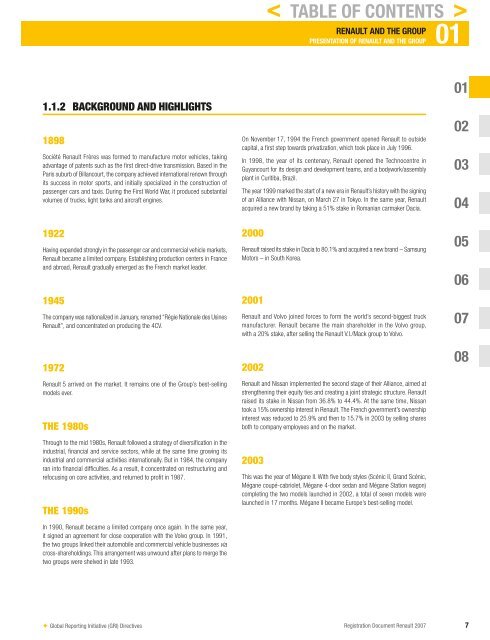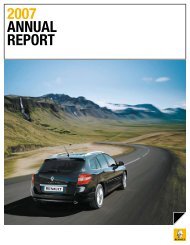2007 Interactive Registration Document - Renault
2007 Interactive Registration Document - Renault
2007 Interactive Registration Document - Renault
You also want an ePaper? Increase the reach of your titles
YUMPU automatically turns print PDFs into web optimized ePapers that Google loves.
1.1.2 BACKGROUND AND HIGHLIGHTS<br />
1898<br />
Société <strong>Renault</strong> Frères was formed to manufacture motor vehicles, taking<br />
advantage of patents such as the fi rst direct-drive transmission. Based in the<br />
Paris suburb of Billancourt, the company achieved international renown through<br />
its success in motor sports, and initially specialized in the construction of<br />
passenger cars and taxis. During the First World War, it produced substantial<br />
volumes of trucks, light tanks and aircraft engines.<br />
1922<br />
Having expanded strongly in the passenger car and commercial vehicle markets,<br />
<strong>Renault</strong> became a limited company. Establishing production centers in France<br />
and abroad, <strong>Renault</strong> gradually emerged as the French market leader.<br />
1945<br />
The company was nationalized in January, renamed “Régie Nationale des Usines<br />
<strong>Renault</strong>”, and concentrated on producing the 4 CV.<br />
1972<br />
<strong>Renault</strong> 5 arrived on the market. It remains one of the Group’s best-selling<br />
models ever.<br />
THE 1980s<br />
Through to the mid 1980s, <strong>Renault</strong> followed a strategy of diversifi cation in the<br />
industrial, fi nancial and service sectors, while at the same time growing its<br />
industrial and commercial activities internationally. But in 1984, the company<br />
ran into fi nancial diffi culties. As a result, it concentrated on restructuring and<br />
refocusing on core activities, and returned to profi t in 1987.<br />
THE 1990s<br />
In 1990, <strong>Renault</strong> became a limited company once again. In the same year,<br />
it signed an agreement for close cooperation with the Volvo group. In 1991,<br />
the two groups linked their automobile and commercial vehicle businesses via<br />
cross-shareholdings. This arrangement was unwound after plans to merge the<br />
two groups were shelved in late 1993.<br />
RENAULT AND THE GROUP 01<br />
PRESENTATION OF RENAULT AND THE GROUP<br />
On November 17, 1994 the French government opened <strong>Renault</strong> to outside<br />
capital, a fi rst step towards privatization, which took place in July 1996.<br />
In 1998, the year of its centenary, <strong>Renault</strong> opened the Technocentre in<br />
Guyancourt for its design and development teams, and a bodywork/assembly<br />
plant in Curitiba, Brazil.<br />
The year 1999 marked the start of a new era in <strong>Renault</strong>’s history with the signing<br />
of an Alliance with Nissan, on March 27 in Tokyo. In the same year, <strong>Renault</strong><br />
acquired a new brand by taking a 51% stake in Romanian carmaker Dacia.<br />
2000<br />
<strong>Renault</strong> raised its stake in Dacia to 80.1% and acquired a new brand – Samsung<br />
Motors – in South Korea.<br />
2001<br />
<strong>Renault</strong> and Volvo joined forces to form the world’s second-biggest truck<br />
manufacturer. <strong>Renault</strong> became the main shareholder in the Volvo group,<br />
with a 20% stake, after selling the <strong>Renault</strong> V.I./Mack group to Volvo.<br />
2002<br />
<strong>Renault</strong> and Nissan implemented the second stage of their Alliance, aimed at<br />
strengthening their equity ties and creating a joint strategic structure. <strong>Renault</strong><br />
raised its stake in Nissan from 36.8% to 44.4%. At the same time, Nissan<br />
took a 15% ownership interest in <strong>Renault</strong>. The French government’s ownership<br />
interest was reduced to 25.9% and then to 15.7% in 2003 by selling shares<br />
both to company employees and on the market.<br />
2003<br />
< TABLE OF CONTENTS ><br />
This was the year of Mégane II. With fi ve body styles (Scénic II, Grand Scénic,<br />
Mégane coupé-cabriolet, Mégane 4-door sedan and Mégane Station wagon)<br />
completing the two models launched in 2002, a total of seven models were<br />
launched in 17 months. Mégane II became Europe’s best-selling model.<br />
✦ Global Reporting Initiative (GRI) Directives <strong>Registration</strong> <strong>Document</strong> <strong>Renault</strong> <strong>2007</strong> 7<br />
01<br />
02<br />
03<br />
04<br />
05<br />
06<br />
07<br />
08




